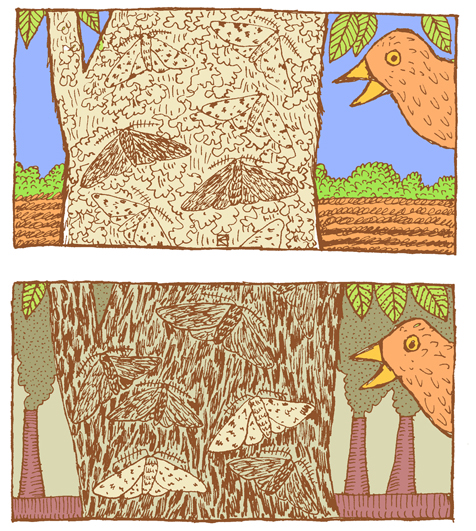The Activity
This activity, called Explain Natural Selection to a Child, falls in the upper middle of Bloom's taxonomy under the "Analyzing" category. Here students are asked to explain natural selection to a child in an elementary school class that we are connected to through ePals. Here each student is paired with one of the students in the elementary class. They will write their summary of how natural selection occurs in simple terms so the child can understand and then the child will respond by asking questions that my student will answer.
The Assessment
The assessment is based on whether or not the student can articulate how natural selection occurs in simple terms. To do this they have to have a solid understanding of how natural selection works. The also need to be able to identify the key points that allow natural selection to work. Focusing on those will help simplify the material for the kids so they are not overwhelmed. Images, such as the one below depicting the evolution in color of Peppered moths during the Industrial Revolution, could also be helpful for describing how evolution occurs to elementary school kids. A rubric will be provided to help guide students through the project to assess the quality of their initial explanation as well as the following correspondence with the child.
 |
| By Khaydock (Own work) [CC BY-SA 3.0 (http://creativecommons.org/licenses/by-sa/3.0)], via Wikimedia Commons |
The Assessment Tool
The assessment tool for this activity is ePals, a website that allows classrooms to connect and collaborate on projects. Instructors post an ad describing what type of class they would like to connect with and other instructors respond if they are interested in coordinating a project. There are many language instructors on ePals looking for another language course for their students to practice corresponding with one another. Other types of classes are on there too, though they are harder to find. One nice thing about ePals is that they have their own email system where, according to their website, "educators can manage and monitor what students see, whom they communicate with and how they interact." This allows me to monitor exchanges between students and grade their work. ePals also allows for other types of interaction, such as video calls, that my students could use if the children were set up to receive them. We could also use the ePals workspace to enhance the children's learning.
Plagiarism and Diversity
In this assignment students are instructed to teach children how natural selection works and then respond to their questions. They have to come up with an interesting way of presenting the material for children and then respond to the specific questions kids ask. This discourages plagiarism because they have to respond to the children. The assignment also allows for diversity in the methods of delivering the material to the children. Written words, images, videos, etc. are all options. My students have different preferences for the way they like to learn best, so they may try delivering the material in a similar style. The children also have different learning styles though, so if the initial try doesn't work well they can try a different approach.
Works Cited
About ePals. (n.d.). Retrieved February 13, 2015, from http://www.epals.com/#!/info/about/
No comments:
Post a Comment